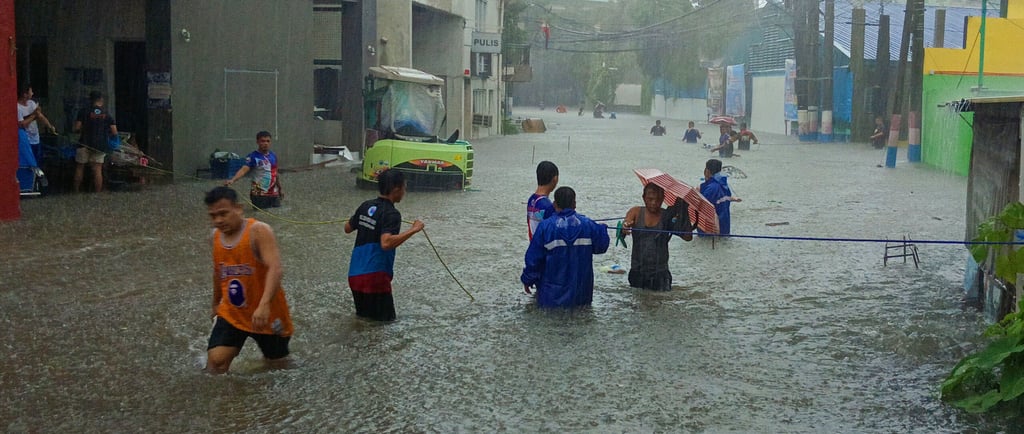Typhoon Carina: A Recent Weather Event Impacting the Philippines
The Philippines, a country frequently hit by natural disasters, has once again faced the fury of nature with the arrival of Typhoon Carina. This recent typhoon has brought about significant weather changes, affecting various regions and communities. In this blog, we'll delve into the details of Typhoon Carina, its impact, and the response efforts in place.
7/24/20243 min read


Overview of Typhoon Carina
Typhoon Carina, also known as Gaemi, intensified from a tropical storm into a severe tropical storm on Sunday evening, July 21, while remaining almost stationary over the Philippine Sea. According to the Philippine Atmospheric, Geophysical, and Astronomical Services Administration (PAGASA), Carina's maximum sustained winds increased from 85 kilometers per hour to 95 km/h, with gustiness up to 115 km/h.
At 10 pm on Sunday, Carina was located 385 kilometers east of Casiguran, Aurora. Despite its slow movement, the severe tropical storm's size means it will still impact some northern provinces.
Impact on Affected Areas
Signal No. 1 Raised
PAGASA raised Signal No. 1 for the northeastern part of Cagayan province, specifically Santa Ana, indicating that strong winds from Carina will be felt within 36 hours.
Rainfall and Flooding
Carina's outer rainbands are expected to bring moderate to intense rain in several areas. From Sunday evening, July 21, to Monday evening, July 22, heavy to intense rain (100-200 millimeters) will affect the extreme northeastern part of mainland Cagayan, while moderate to heavy rain (50-100 mm) will impact the Babuyan Islands, eastern mainland Cagayan, and eastern Isabela.
From Monday evening, July 22, to Tuesday evening, July 23, heavy to intense rain will continue in the Babuyan Islands and northeastern mainland Cagayan, with moderate to heavy rain in Batanes and the rest of mainland Cagayan.
From Tuesday evening, July 23, to Wednesday evening, July 24, heavy to intense rain will hit Batanes, while the Babuyan Islands will experience moderate to heavy rain.
Floods and landslides are possible due to the heavy rainfall.
Enhanced Southwest Monsoon
Carina is also enhancing the southwest monsoon, or habagat, affecting parts of Luzon over the next three days. The enhanced southwest monsoon will cause rain, potentially leading to floods and landslides in the following areas:
Monday, July 22
Moderate to heavy rain (50-100 mm): La Union, Pangasinan, Benguet, Zambales, Bataan, Occidental Mindoro
Moderate to occasionally heavy rain (50-100 mm): Metro Manila, Ilocos Norte, Ilocos Sur, Abra, Tarlac, Pampanga, Bulacan, Nueva Ecija, Rizal, Cavite, Batangas, Calamian Islands
Tuesday, July 23
Heavy to intense rain (100-200 mm): Ilocos Region, Benguet, Zambales, Bataan, Occidental Mindoro
Moderate to heavy rain (50-100 mm): Metro Manila, Apayao, Abra, Tarlac, Pampanga, Bulacan, Nueva Ecija, Rizal, Cavite, Laguna, Batangas, Calamian Islands
Wednesday, July 24
Heavy to intense rain (100-200 mm): Ilocos Sur, La Union, Pangasinan, Benguet, Zambales, Bataan, Occidental Mindoro
Moderate to heavy rain (50-100 mm): Metro Manila, Ilocos Norte, Apayao, Abra, Tarlac, Pampanga, Bulacan, Nueva Ecija, Rizal, Cavite, Laguna, Batangas, Calamian Islands
Strong Winds and Rough Seas
Strong to gale-force gusts from the enhanced southwest monsoon will affect several regions and provinces:
Sunday evening, July 21, to Monday evening, July 22
Mimaropa, Bicol, Western Visayas, Northern Samar, northern part of Samar
Monday evening, July 22, to Tuesday evening, July 23
Zambales, Bataan, Metro Manila, Calabarzon, Mimaropa, Bicol, Visayas
Tuesday evening, July 23, to Wednesday evening, July 24
Ilocos Region, Central Luzon, Metro Manila, Calabarzon, Mimaropa, Bicol, Visayas
In addition, Carina and the enhanced southwest monsoon will cause moderate to rough seas in the northern and eastern seaboards of the country, and the western seaboards of Central and Southern Luzon, with waves ranging from 1.5 to 3.5 meters high. PAGASA has advised small boats not to venture out to sea.
Government and Community Response
The Philippine government, through its disaster response agencies, activated emergency protocols to mitigate the impact of Typhoon Carina. The National Disaster Risk Reduction and Management Council (NDRRMC) coordinated with local government units to ensure timely evacuation, distribution of relief goods, and provision of medical assistance.
Evacuation Centers
Evacuation centers were set up in affected regions to provide temporary shelter to displaced families. These centers offered essential services, including food, water, and medical care, ensuring the safety and well-being of evacuees.
Relief Operations
Humanitarian organizations and government agencies launched relief operations to deliver aid to affected communities. Relief packs containing food, water, clothing, and hygiene kits were distributed to those in need, helping them cope with the immediate aftermath of the typhoon.
The Role of Technology in Disaster Management
In recent years, advancements in technology have played a crucial role in disaster management. Early warning systems, weather forecasting, and real-time communication have significantly improved the country's ability to respond to natural disasters like Typhoon Carina.
Early Warning Systems
PAGASA issued timely weather updates and warnings, enabling residents to prepare for the typhoon's impact. These early warnings helped save lives and minimize damage by allowing communities to take necessary precautions.
Social Media and Communication
Social media platforms served as vital tools for disseminating information and coordinating relief efforts. Government agencies, non-governmental organizations, and individuals used social media to share updates, call for assistance, and organize community-driven initiatives.
Conclusion
Typhoon Carina serves as a stark reminder of the vulnerability of the Philippines to natural disasters. While the country continues to face challenges posed by such events, the resilience and solidarity of its people, coupled with technological advancements, provide hope for better disaster management and recovery.
As the nation rebuilds and recovers from the aftermath of Typhoon Carina, it is crucial to strengthen disaster preparedness measures and continue investing in technologies that enhance resilience. By doing so, the Philippines can better protect its communities and ensure a safer future for all.
Address
U.S. Office: Carson CA 90745
Philippine Office: Cainta Rizal Philippines 90745
Contacts
Services
Industries
Company
Los Angeles
561-244-8761 213-301-0541
Philippines
(63) 947-820-8532 (63) 942-053-5238
DTI/Business Permit No. 5381185


Los Angeles


The domain www.OwatchTechnology.com is officially owned and managed by Overwatch Technology OPC.
We do not sell services through third parties, resellers, or unofficial social media accounts.
If you receive any messages or solicitations not from @OwatchTechnology.com, please report them to support@OwatchTechnology.com.
